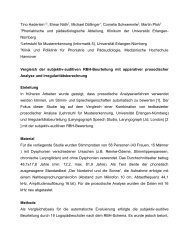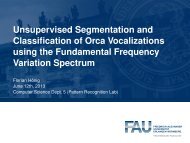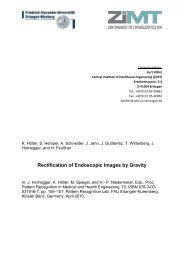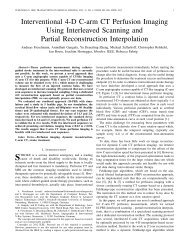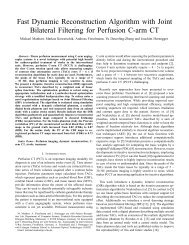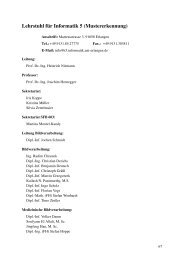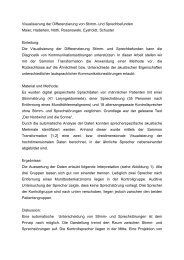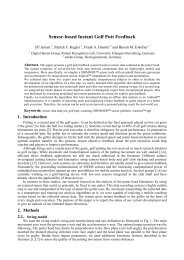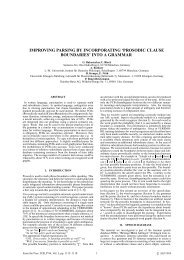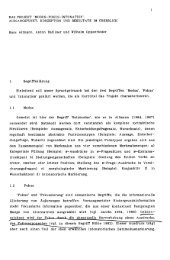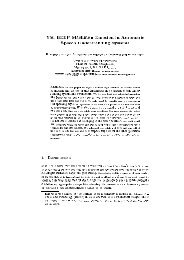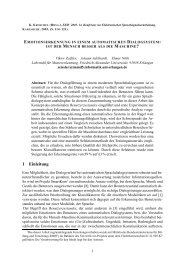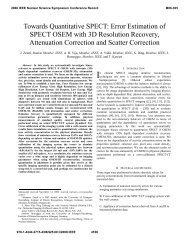Using Quaternions for Parametrizing 3-D Rotations in ...
Using Quaternions for Parametrizing 3-D Rotations in ...
Using Quaternions for Parametrizing 3-D Rotations in ...
You also want an ePaper? Increase the reach of your titles
YUMPU automatically turns print PDFs into web optimized ePapers that Google loves.
Jochen Schmidt and He<strong>in</strong>rich Niemann<br />
<strong>Us<strong>in</strong>g</strong> <strong>Quaternions</strong> <strong>for</strong> <strong>Parametriz<strong>in</strong>g</strong> 3–D <strong>Rotations</strong> <strong>in</strong> Unconstra<strong>in</strong>ed Nonl<strong>in</strong>ear Optimization<br />
appeared <strong>in</strong>:<br />
Vision, Model<strong>in</strong>g, and Visualization 2001 (VMV 2001)<br />
Stuttgart, Germany<br />
p. 399-406<br />
666
<strong>Us<strong>in</strong>g</strong> <strong>Quaternions</strong> <strong>for</strong> <strong>Parametriz<strong>in</strong>g</strong> 3–D <strong>Rotations</strong> <strong>in</strong> Unconstra<strong>in</strong>ed<br />
Nonl<strong>in</strong>ear Optimization<br />
J. Schmidt and H. Niemann<br />
Chair <strong>for</strong> Pattern Recognition (In<strong>for</strong>matik 5), University of Erlangen–Nuremberg<br />
Martensstr. 3, 91058 Erlangen, Germany<br />
Email: {jschmidt,niemann}@<strong>in</strong><strong>for</strong>matik.uni-erlangen.de<br />
Abstract<br />
In this paper we address the problem of us<strong>in</strong>g<br />
quaternions <strong>in</strong> unconstra<strong>in</strong>ed nonl<strong>in</strong>ear optimization<br />
of 3-D rotations. <strong>Quaternions</strong> represent<strong>in</strong>g rotations<br />
have four elements but only three degrees<br />
of freedom, s<strong>in</strong>ce they must be of norm one. This<br />
constra<strong>in</strong>t has to be taken <strong>in</strong>to account when apply<strong>in</strong>g<br />
e. g. the Levenberg-Marquardt algorithm, a<br />
method <strong>for</strong> unconstra<strong>in</strong>ed nonl<strong>in</strong>ear optimization<br />
widely used <strong>in</strong> computer vision. We propose an<br />
easy to use method <strong>for</strong> achiev<strong>in</strong>g this. Experiments<br />
us<strong>in</strong>g our parametrization <strong>in</strong> photogrammetric<br />
bundle-adjustment are presented at the end of the<br />
paper.<br />
1 Introduction<br />
Many tasks <strong>in</strong> computer vision require the estimation<br />
of 3-D rotation matrices, usually us<strong>in</strong>g a l<strong>in</strong>ear<br />
algorithm first and a nonl<strong>in</strong>ear ref<strong>in</strong>ement afterwards.<br />
Examples <strong>in</strong>clude camera calibration [2, 3]<br />
or photogrammetric bundle-adjustment [4, 6, 10,<br />
3] <strong>in</strong> structure-from-motion applications. An often<br />
used [4, 6, 10, 3] method <strong>for</strong> do<strong>in</strong>g nonl<strong>in</strong>ear<br />
ref<strong>in</strong>ement is the Gauss-Newton algorithm with<br />
Levenberg-Marquardt extension [3, 11], which is an<br />
iterative algorithm <strong>for</strong> unconstra<strong>in</strong>ed optimization.<br />
S<strong>in</strong>ce a 3×3 rotation matrix has 9 elements but only<br />
3 degrees of freedom (DOF), other parametrizations<br />
are used <strong>for</strong> rotations <strong>in</strong> 3-D: Euler angles,<br />
axis/angle representation, and quaternions.<br />
<strong>Quaternions</strong> have advantages <strong>in</strong> many applications,<br />
they are used <strong>for</strong> example <strong>in</strong> computer vision<br />
<strong>for</strong> a numerically stable estimation of rotation from<br />
an essential matrix [2], or <strong>in</strong> computer graphics <strong>for</strong><br />
<strong>in</strong>terpolation between two given rotations, s<strong>in</strong>ce the<br />
use of quaternions yields smooth movements, while<br />
Euler angles do not [16].<br />
This contribution focuses on quaternions, but<br />
because of the strong dependencies between<br />
axis/angle representation and quaternions a short review<br />
of the other two parametrizations is given first.<br />
2 <strong>Parametriz<strong>in</strong>g</strong> <strong>Rotations</strong><br />
2.1 Fair Parametrizations<br />
The term fair parametrization was <strong>in</strong>troduced by<br />
Hornegger and Tomasi <strong>in</strong> [8]. A parametrization<br />
is called fair, if it does not <strong>in</strong>troduce more numerical<br />
sensitivity than <strong>in</strong>herent to the problem itself.<br />
This is guaranteed, if any rigid trans<strong>for</strong>mation of<br />
the space to be parametrized results <strong>in</strong> an orthogonal<br />
trans<strong>for</strong>mation of the parameters. S<strong>in</strong>ce this<br />
is a rather general def<strong>in</strong>ition, it is not restricted to<br />
parametriz<strong>in</strong>g rotations, but <strong>in</strong> [8] the parametrization<br />
of camera motion is treated.<br />
2.2 Euler Angles<br />
Represent<strong>in</strong>g a rotation by Euler angles is probably<br />
the best known parametrization. A rotation matrix<br />
can be built from three matrices represent<strong>in</strong>g<br />
rotations around the axes of the coord<strong>in</strong>ate-system,<br />
where each rotation is def<strong>in</strong>ed by an angle. As<br />
matrix multiplication is not commutative, the Euler<br />
angle representation is not unique, mean<strong>in</strong>g that<br />
a permutation of the order of the rotations around<br />
the axes yields different Euler angles. Probably the<br />
most important drawback of this parametrization is<br />
the existence of so-called gimbal lock s<strong>in</strong>gularities,<br />
where one DOF is lost, i. e. two of the three Euler<br />
angles belong to the same DOF. For a deeper discussion<br />
see [16].<br />
S<strong>in</strong>ce Euler angles are not a fair parametrization<br />
of rotations accord<strong>in</strong>g to [8] either and thus are nu-<br />
VMV 2001 Stuttgart, Germany, November 21–23, 2001
θ<br />
axis a<br />
quaternions <strong>in</strong> computer vision can be found <strong>in</strong> [2].<br />
They are a fair parametrization <strong>in</strong> the sense of [8].<br />
A quaternion h is def<strong>in</strong>ed as follows:<br />
Figure 1: Rotation around an axis a by angle θ.<br />
merically <strong>in</strong>stable <strong>for</strong> estimat<strong>in</strong>g rotations, we do<br />
not discuss them any further.<br />
2.3 Axis/Angle Representation<br />
The parametrization most widely used <strong>in</strong> bundleadjustment<br />
[6, 7, 13] is the axis/angle representation.<br />
It is a fair parametrization <strong>in</strong> the sense of [8].<br />
=<br />
An arbitrary rotation R ∈ IR 3×3 can be represented<br />
as a rotation around one axis a ∈ IR 3 by the<br />
angle θ (see Figure 1). S<strong>in</strong>ce only the direction of<br />
the rotation axis a is of importance, a has only 2<br />
DOF. Hence axis and angle can be comb<strong>in</strong>ed <strong>in</strong>to a<br />
s<strong>in</strong>gle 3-vector, its direction giv<strong>in</strong>g the rotation<br />
axis and its length the rotation angle:<br />
θ = ||, a . (1)<br />
||<br />
Comput<strong>in</strong>g a rotation matrix R fromcan be done<br />
by us<strong>in</strong>g the <strong>for</strong>mula of Rodrigues [2]:<br />
R = e [] ×<br />
= I s<strong>in</strong> θ 3+<br />
θ [] 1 − cos θ<br />
×+ [] 2 θ 2 × ,<br />
(2)<br />
where [] × is the follow<strong>in</strong>g antisymmetric matrix:<br />
=¾¼ω =¼0 −ω 3 ω 2<br />
[] × ω 3 0 −ω 1<br />
1<br />
ω 2<br />
ω 3½¿×<br />
(3)<br />
The computation of axis and angle from a rotation<br />
matrix R can be done as follows [15]: Eigendecomposition<br />
of R yields the three Eigen-values 1<br />
and cos θ ± is<strong>in</strong> θ. The axis a is the Eigen-vector<br />
correspond<strong>in</strong>g to the Eigen-value 1. The angle θ can<br />
now be calculated from one of the rema<strong>in</strong><strong>in</strong>g Eigenvalues.<br />
The consistency of the direction of the axis<br />
and the angle can be checked by <strong>in</strong>sert<strong>in</strong>g them <strong>in</strong>to<br />
equation (2).<br />
2.4 <strong>Quaternions</strong><br />
−ω 2 ω 1 0½.<br />
<strong>Quaternions</strong> are numbers, <strong>in</strong> a certa<strong>in</strong> sense similar<br />
to complex numbers: Instead of us<strong>in</strong>g only<br />
one imag<strong>in</strong>ary part, three are <strong>in</strong>troduced. More on<br />
h = w+xi+yj+zk, w, x,y, z ∈ IR , (4)<br />
where w is the real part and x,y, z are the imag<strong>in</strong>ary<br />
parts. Multiplication and summation are done<br />
component-wise, with<br />
i 2 = j 2 = k 2 = −1 ,<br />
ij = −ji = k ,<br />
jk = −kj = i ,<br />
ki = −ik = j .<br />
(5)<br />
Often a quaternion is written as a 4-tupel h =<br />
(w, x, y, z) or h = (w,v), where v is a 3-vector<br />
conta<strong>in</strong><strong>in</strong>g the imag<strong>in</strong>ary parts. In contrast to complex<br />
numbers, the commutative law of multiplication<br />
is not valid, i. e. h 1h 2 ≠ h 2h 1. Similar to<br />
complex numbers, a conjugate quaternion is def<strong>in</strong>ed<br />
as h = w −xi −yj −zk. The norm of a quaternion<br />
h is |h| =Ôh · h =Ôw 2 + x 2 + y 2 + z 2 . For<br />
unit quaternions (|h| = 1), the <strong>in</strong>verse of multiplication<br />
equals the conjugate: h −1 = h.<br />
Just as the multiplication of two unit complex<br />
numbers def<strong>in</strong>es a rotation <strong>in</strong> 2-D, a multiplication<br />
of two unit quaternions yields a rotation <strong>in</strong> 3-D. Let<br />
p be a 3-D po<strong>in</strong>t to be rotated, a a rotation axis<br />
with |a| = 1, and θ the angle of rotation around<br />
this axis as <strong>in</strong> Section 2.3. Def<strong>in</strong>e the follow<strong>in</strong>g two<br />
quaternions:<br />
h =cos θ 2 ,s<strong>in</strong> θ 2 · a,<br />
(6)<br />
p ′ = (0,p) .<br />
a¡<br />
Then<br />
p ′ rot = h · p′ · h , (7)<br />
where p ′ rot is the quaternion correspond<strong>in</strong>g to the<br />
rotated po<strong>in</strong>t.<br />
Note that the representation of a rotation as a<br />
quaternion (and also as axis/angle) is not unique,<br />
s<strong>in</strong>ce the two quaternions h 1 = cos θ ,s<strong>in</strong> θ · 2 2<br />
and h 2 = −cos θ , − s<strong>in</strong> θ · a¡def<strong>in</strong>e the same<br />
2 2<br />
rotation. This is a direct result of the axis/angle representation,<br />
because a rotation around an axis a by<br />
an angle θ is the same as a rotation around the axis<br />
−a by the angle 2π − θ. Which one of the two<br />
quaternions is used does not matter, but one has to<br />
666
e careful when measur<strong>in</strong>g the distance of two rotations<br />
(e. g. <strong>for</strong> describ<strong>in</strong>g the calibration error) by<br />
the distance between quaternions.<br />
The computation of a quaternion from a rotation<br />
matrix is done us<strong>in</strong>g the axis/angle representation<br />
as described <strong>in</strong> equation (6). The computation of a<br />
rotation matrix R from a quaternion can be done as<br />
follows [2]:<br />
where<br />
r 1 =¼h<br />
R = r 1 r 2 r 3¡, (8)<br />
2<br />
0 + h 2 1 − h 2 2 − h 2 3<br />
2(h 1h 2 + h 0h 3)<br />
2)½,<br />
2(h 1h 3 − h 0h<br />
1)½,<br />
2(h 2h 3 + h 0h<br />
3½.<br />
h 2 0 − h 2 1 − h 2 2 + h 2<br />
r 2 =¼2(h 1h 2 − h 0h 3)<br />
h 2 0 − h 2 1 + h 2 2 − h 2 3<br />
r 3 =¼2(h 1h 3 + h 0h 2)<br />
2(h 2h 3 − h 0h 1)<br />
(9)<br />
3 Unconstra<strong>in</strong>ed Nonl<strong>in</strong>ear Optimization<br />
Nonl<strong>in</strong>ear Optimization is usually per<strong>for</strong>med after<br />
a l<strong>in</strong>ear step, i. e. an <strong>in</strong>itial estimation of the rotation<br />
matrix exists already. The correspond<strong>in</strong>g<br />
quaternion is denoted here as h 0. When us<strong>in</strong>g an<br />
unconstra<strong>in</strong>ed nonl<strong>in</strong>ear optimization method like<br />
the Levenberg-Marquardt algorithm, the ma<strong>in</strong> problem<br />
is that a quaternion represent<strong>in</strong>g a rotation<br />
has four elements but only 3 DOF because of the<br />
norm–1 constra<strong>in</strong>t. This has to be considered dur<strong>in</strong>g<br />
the optimization process. Additionally a m<strong>in</strong>imal<br />
parametrization is desired because of computation<br />
time, especially if we consider the problem<br />
of bundle-adjustment where many 3-D rotations are<br />
optimized simultaneously.<br />
3.1 Possible Solutions<br />
At the beg<strong>in</strong>n<strong>in</strong>g of this section we will discuss<br />
some possible solutions <strong>for</strong> this problem, after that<br />
our approach is described <strong>in</strong> detail.<br />
Use all four elements of the quaternion. The<br />
simplest way to do nonl<strong>in</strong>ear optimization us<strong>in</strong>g<br />
quaternions is to ignore the norm–1 constra<strong>in</strong>t completely<br />
and change all four elements. After optimization,<br />
the result<strong>in</strong>g quaternion is <strong>for</strong>ced to<br />
norm 1. This approach has two drawbacks: On the<br />
one hand, four parameters are changed where three<br />
would be sufficient, on the other hand the norm<br />
changes dur<strong>in</strong>g optimization, while it would be desired<br />
to be preserved.<br />
Lagrange. A standard way to deal with constra<strong>in</strong>ts<br />
is the <strong>in</strong>troduction of Lagrangian multipliers.<br />
There<strong>for</strong>e the function to be optimized must<br />
be extended by a term of the <strong>for</strong>m λ i(h T i h i − 1).<br />
This is not a problem <strong>in</strong> pr<strong>in</strong>ciple, but has the disadvantage<br />
that the number of parameters to be estimated<br />
<strong>in</strong>creases from four to five, because of the<br />
Lagrangian multipliers λ i. In bundle-adjustment,<br />
where a whole image sequence is processed at once<br />
and thus a rotation has to be computed <strong>for</strong> each<br />
image, this results <strong>in</strong> additional computation time<br />
needed.<br />
One possibility would be to fix the λ i be<strong>for</strong>e optimization<br />
<strong>in</strong> order regularize the problem <strong>in</strong>stead of<br />
estimat<strong>in</strong>g them. This approach punishes deviations<br />
from the norm–1 constra<strong>in</strong>t by <strong>in</strong>creas<strong>in</strong>g the residual.<br />
An exact compliance (with<strong>in</strong> numerical precision)<br />
with the constra<strong>in</strong>t however is not ensured,<br />
and additionally the question arises to what values<br />
to fix the λ i.<br />
Use only the imag<strong>in</strong>ary parts of the quaternion.<br />
This parametrization is used <strong>in</strong> [1], but not <strong>for</strong> nonl<strong>in</strong>ear<br />
optimization. Three parameters κ x, κ y, and<br />
κ z are changed here, from which the quaternion h<br />
is calculated as<br />
h =Ö1 − (κ2 x + κ 2 y + κ 2 z)<br />
, κx<br />
4 2 , κy<br />
2 , κz<br />
2.<br />
(10)<br />
The advantage is that only the m<strong>in</strong>imum number of<br />
three parameters is used. But it has to be made sure<br />
that the changes are done <strong>in</strong> a way that the radicand<br />
is always positive, which cannot be guaranteed<br />
when per<strong>for</strong>m<strong>in</strong>g Levenberg-Marquardt optimization.<br />
This is why we do not use this approach.<br />
Conclusion: A parametrization has to be found,<br />
that:<br />
• is m<strong>in</strong>imal, i. e. it uses only three parameters,<br />
666
h 0<br />
v<br />
θ<br />
O<br />
h v<br />
h Z<br />
Figure 2: Parametrization of rotation by quaternions:<br />
The tangential hyperplane touches the unit<br />
sphereË3 <strong>in</strong> h 0. h v is the quaternion ly<strong>in</strong>g <strong>in</strong> this<br />
hyperplane, h Z is the result<strong>in</strong>g quaternion.<br />
• the three parameters can be changed arbitrarily<br />
by the optimization algorithm,<br />
• the result<strong>in</strong>g quaternion has always norm 1.<br />
In the follow<strong>in</strong>g we present a technique <strong>for</strong> accomplish<strong>in</strong>g<br />
this.<br />
3.2 New Approach<br />
We now describe a way <strong>for</strong> parametriz<strong>in</strong>g changes<br />
<strong>in</strong> rotation start<strong>in</strong>g at an <strong>in</strong>itial solution obta<strong>in</strong>ed<br />
e. g. by a l<strong>in</strong>ear method. We will call that start<strong>in</strong>g<br />
quaternion h 0 the operat<strong>in</strong>g po<strong>in</strong>t. All quaternions<br />
of norm 1 lie on the unit sphere <strong>in</strong> IR 4 , i. e. theË3 .<br />
The goal is to use three parameters <strong>for</strong> giv<strong>in</strong>g the direction<br />
and distance of the result<strong>in</strong>g quaternion on<br />
this sphere. There<strong>for</strong>e we use the shortest connection<br />
between two po<strong>in</strong>ts on a sphere, i. e. a great circle.<br />
In the follow<strong>in</strong>g we will show how this can be<br />
accomplished. Figure 2 shows the general sett<strong>in</strong>g.<br />
For describ<strong>in</strong>g a movement on the sphere start<strong>in</strong>g<br />
at h 0 we use a vector v 4 ∈ IR 4 ly<strong>in</strong>g <strong>in</strong> the<br />
tangential hyperplane that touches the sphere <strong>in</strong> h 0.<br />
This hyperplane is a subspace of IR 4 , thus vectors<br />
<strong>in</strong> this plane can be represented as 3-vectors with<br />
respect to a local coord<strong>in</strong>ate system spann<strong>in</strong>g the<br />
plane. The correspond<strong>in</strong>g 3-vector to v 4 we call<br />
v ∈ IR 3 . The orig<strong>in</strong> of this system is h 0.<br />
There<strong>for</strong>e we use a 3-vector encod<strong>in</strong>g a direction<br />
along a great circle, its length giv<strong>in</strong>g the distance<br />
to move on the great circle <strong>for</strong> parametriz<strong>in</strong>g<br />
quaternions <strong>in</strong> nonl<strong>in</strong>ear optimization. S<strong>in</strong>ce we<br />
consider quaternions ly<strong>in</strong>g on a unit sphere, the distance<br />
equals the angle between the operat<strong>in</strong>g po<strong>in</strong>t<br />
h 0 and the result<strong>in</strong>g quaternion h Z measured <strong>in</strong> radian.<br />
The great circle on which the movement is to<br />
be done is def<strong>in</strong>ed by <strong>in</strong>tersect<strong>in</strong>g the sphere with<br />
the 2-D plane through the orig<strong>in</strong> that is spanned by<br />
the operat<strong>in</strong>g po<strong>in</strong>t h 0 and v 4. The further text is<br />
divided <strong>in</strong> three parts:<br />
1. Computation of an orthogonal basis of the tangential<br />
hyperplane. This basis is the local coord<strong>in</strong>ate<br />
system <strong>for</strong> v.<br />
2. Conversion of the 3-vector v to a 4-vector ly<strong>in</strong>g<br />
<strong>in</strong> the hyperplane.<br />
3. Computation of the result<strong>in</strong>g quaternion h Z.<br />
3.2.1 Basis of the Tangential Hyperplane<br />
First we compute the hyperplane tangential to the<br />
sphere <strong>in</strong> h 0. This plane is def<strong>in</strong>ed by all po<strong>in</strong>ts<br />
x ∈ IR 4 satisfy<strong>in</strong>g<br />
h 0 T x = 1 , (11)<br />
s<strong>in</strong>ce h 0 is a normal vector of the plane. In order to<br />
dist<strong>in</strong>guish the normal vector from the quaternion,<br />
<strong>in</strong> the follow<strong>in</strong>g we denote the normal vector by n.<br />
But one should keep <strong>in</strong> m<strong>in</strong>d that<br />
n = n 1 n 2 n 3 n 4¡T<br />
= h0 . (12)<br />
This gives the plane equation <strong>in</strong> normal <strong>for</strong>m:<br />
n 1x 1 + n 2x 2 + n 3x 3 + n 4x 4 − 1 = 0 . (13)<br />
S<strong>in</strong>ce we do not need this equation but rather a basis<br />
of the subspace def<strong>in</strong>ed by this plane, we convert<br />
equation (13) to parameter <strong>for</strong>m. There<strong>for</strong>e we<br />
choose one element of n not equal to zero 1 . Let<br />
this be without loss of generality n 1. Now choose<br />
the three parameters λ = x 2, µ = x 3 and ν = x 4.<br />
Plugg<strong>in</strong>g these <strong>in</strong>to (13) and solv<strong>in</strong>g <strong>for</strong> x 1 gives:<br />
x 1 = 1 n 1<br />
(1 − n 2x 2 − n 3x 3 − n 4x 4) ,<br />
x 2 = λ, x 3 = µ, x 4 = ν .<br />
Thus we get a parameter <strong>for</strong>m of the plane:<br />
(14)<br />
x = a + λb ′ 1 + µb ′ 2 + νb ′ 3 , (15)<br />
1 there will always be one n i not equal to zero, s<strong>in</strong>ce |n| = 1.<br />
666
where<br />
a =<br />
1<br />
n 1<br />
0 0 0¡T<br />
,<br />
b ′ 1 = − n 2<br />
n 1<br />
1 0 0¡T<br />
,<br />
(16)<br />
b ′ 2 = − n 3<br />
n 1<br />
0 1 0¡T<br />
,<br />
b ′ 3 = − n 4<br />
n 1<br />
0 0 1¡T<br />
.<br />
Now we have a basis B ′ <strong>for</strong> the hyperplane:<br />
B ′ = b ′ 1 b ′ 2 b ′ 3¡. (17)<br />
Note that this basis is not yet orthogonal. To avoid<br />
numerical <strong>in</strong>stabilities an orthogonal basis B is<br />
computed from B ′ . There<strong>for</strong>e we use the s<strong>in</strong>gular<br />
value decomposition (SVD) [11] of B ′ which is<br />
given as:<br />
B ′ = BΣV T . (18)<br />
Then the 4 × 3 matrix B is an orthonormal basis<br />
spann<strong>in</strong>g the same subspace as B ′ .<br />
3.2.2 3-D/4-D Conversion of v<br />
Given an arbitrary 3-vector v with respect to the<br />
basis B, a 4-vector v 4 ly<strong>in</strong>g <strong>in</strong> the tangential hyperplane<br />
can be computed by:<br />
v 4 = Bv . (19)<br />
3.2.3 Comput<strong>in</strong>g the Result<strong>in</strong>g Quaternion<br />
The quaternion h Z we look <strong>for</strong> lies on the great circle<br />
def<strong>in</strong>ed by the <strong>in</strong>tersection of the sphere with the<br />
2-D plane through the orig<strong>in</strong> spanned by h 0 and v 4:<br />
x = λh 0 + µv 4N , (20)<br />
where<br />
v 4N = v4<br />
. (21)<br />
|v 4|<br />
Normalization of v 4 is of course not necessary <strong>for</strong><br />
establish<strong>in</strong>g the plane equation (20). The follow<strong>in</strong>g<br />
computations will become more clear, however.<br />
The vectors h 0 and v 4N build an orthogonal coord<strong>in</strong>ate<br />
system whose orig<strong>in</strong> co<strong>in</strong>cides with the orig<strong>in</strong><br />
of the sphere. The quaternion h Z is a vector ly<strong>in</strong>g <strong>in</strong><br />
that plane build<strong>in</strong>g an angle θ with h 0 (see Figure<br />
3). We get h Z as a l<strong>in</strong>ear comb<strong>in</strong>ation of the two<br />
vectors spann<strong>in</strong>g the plane:<br />
where<br />
h Z = s<strong>in</strong>(θ)v 4N + cos(θ)h 0 , (22)<br />
θ = |v 4| . (23)<br />
It is easily shown that the result<strong>in</strong>g quaternion h Z is<br />
of norm 1.<br />
h 0<br />
θ<br />
s<strong>in</strong> θ<br />
h Z<br />
v 4N<br />
cos θ<br />
Figure 3: The vectors h 0 and v 4N give an orthonormal<br />
basis of the plane conta<strong>in</strong><strong>in</strong>g the result<strong>in</strong>g<br />
quaternion h Z .<br />
3.2.4 Summary<br />
We will now give a short summary of the steps necessary<br />
to use our parametrization. Be<strong>for</strong>e per<strong>for</strong>m<strong>in</strong>g<br />
the nonl<strong>in</strong>ear optimization do once:<br />
• compute operat<strong>in</strong>g po<strong>in</strong>t h 0 from given rotation<br />
matrix,<br />
• compute basis vectors b ′ i (i = 1, 2, 3), build a<br />
4 × 3 matrix B ′ ,<br />
• compute an orthonormal basis B from B ′ us<strong>in</strong>g<br />
SVD,<br />
• <strong>in</strong>itialize parameter vector v = 0 .<br />
Dur<strong>in</strong>g optimization only the follow<strong>in</strong>g computations<br />
are necessary to get an optimized quaternion<br />
h Z from the parameter vector v:<br />
• convert the 3-vector v to a 4-vector v 4 us<strong>in</strong>g<br />
equation (19),<br />
• compute the result<strong>in</strong>g quaternion h Z from v 4<br />
us<strong>in</strong>g equation (22),<br />
• if desired convert h Z to a rotation matrix us<strong>in</strong>g<br />
equation (8).<br />
4 Experimental Results<br />
For the experiments we chose photogrammetric<br />
bundle-adjustment [4, 6, 10, 3], i. e. nonl<strong>in</strong>ear optimization<br />
of camera parameters and scene po<strong>in</strong>ts<br />
us<strong>in</strong>g multiple views of a scene simultaneously.<br />
Bundle-adjustment m<strong>in</strong>imizes the back-projection<br />
error, i. e. the root mean square error per image<br />
666
ÚÙØ1<br />
mn<br />
po<strong>in</strong>t <strong>in</strong> pixels, which is given by:<br />
mi=1<br />
(x ij − ˜x ij) 2 + (y ij − ỹ ij) 2¡,<br />
nj=1<br />
500<br />
(24)<br />
where n is the number of frames, m the number of<br />
3-D po<strong>in</strong>ts, (x ij, y ij) a detected feature po<strong>in</strong>t, and<br />
(˜x ij, ỹ ij) the back-projection of a reconstructed<br />
3-D po<strong>in</strong>t i <strong>in</strong>to frame j.<br />
Be<strong>for</strong>e bundle-adjustment, a l<strong>in</strong>ear structurefrom-motion<br />
method was applied to get an <strong>in</strong>itial<br />
reconstruction of scene geometry and camera positions.<br />
This method is described <strong>in</strong> [5]; it is based<br />
upon [14], and by apply<strong>in</strong>g self-calibration methods<br />
[3] reconstruction is possible up to an unknown<br />
similarity trans<strong>for</strong>mation. S<strong>in</strong>ce the camera matrices<br />
obta<strong>in</strong>ed this way are still slightly projectively<br />
distorted, they are <strong>for</strong>ced to be Euclidean by orthogonalization<br />
of rotation matrices us<strong>in</strong>g SVD.<br />
For bundle-adjustment we applied our own implementation<br />
of the Levenberg-Marquardt algorithm,<br />
which is capable of exploit<strong>in</strong>g the special<br />
block-structure of the Jacobian <strong>in</strong> <strong>in</strong>terleaved<br />
bundle-adjustment [13]. More details on the algorithm<br />
and the experiments can be found <strong>in</strong> [12].<br />
We used 8 scenes generated synthetically,<br />
i. e. with known ground truth, two of which are<br />
shown <strong>in</strong> Figure 4. First we give a short summary<br />
of their properties:<br />
• Each scene consists of 100 3-D po<strong>in</strong>ts <strong>in</strong> 20<br />
frames. The po<strong>in</strong>ts were randomly distributed<br />
with<strong>in</strong> a cube of side length 200 mm. Each<br />
po<strong>in</strong>t is visible <strong>in</strong> all frames.<br />
• The distance and view<strong>in</strong>g direction of each<br />
camera was varied randomly, thus simulat<strong>in</strong>g<br />
the behaviour of a hand-held camera.<br />
• The focal lengths f x and f y were chosen randomly<br />
from the <strong>in</strong>tervall 800 – 1200 pixels,<br />
assum<strong>in</strong>g quadratic pixels, i. e. f x = f y. The<br />
values <strong>for</strong> f x and f y were chosen such that they<br />
correspond to a camera with a 1/2”-CCD-Chip<br />
and a focal length of 8 mm. There<strong>for</strong>e the coord<strong>in</strong>ates<br />
of the image po<strong>in</strong>ts are of the same<br />
order of magnitude as <strong>in</strong> a PAL-image.<br />
• The pr<strong>in</strong>cipal po<strong>in</strong>t (u 0, v 0) was chosen as<br />
(0, 0).<br />
• The 3-D po<strong>in</strong>ts were projected <strong>in</strong>to each<br />
frame, Gaussian noise with standard deviation<br />
σ of 0.3, 0.7, and 1.0 pixel was added <strong>in</strong>dependently<br />
<strong>for</strong> each coord<strong>in</strong>ate, giv<strong>in</strong>g a total<br />
400<br />
300<br />
200<br />
100<br />
0<br />
−100<br />
−200<br />
−300<br />
−400<br />
−500<br />
0<br />
50<br />
50<br />
0<br />
−50<br />
0<br />
−50<br />
0<br />
100<br />
200<br />
300<br />
(a) radial camera motion<br />
−400<br />
−300<br />
−200<br />
−100<br />
0<br />
100<br />
200<br />
400<br />
300<br />
(b) translatorial camera motion<br />
Figure 4: Examples of the scenes used <strong>for</strong> simulation:<br />
The 3-D world po<strong>in</strong>ts (circles) are located<br />
with<strong>in</strong> a cube centered at the orig<strong>in</strong>, the camera was<br />
moved <strong>in</strong> a radial (a) or translatorial (b) way. The<br />
arrows give the view<strong>in</strong>g direction of the cameras at<br />
their respective position. All units <strong>in</strong> mm.<br />
of 24 different image sequences.<br />
In Table 1 we give some selected results from our 24<br />
sequences obta<strong>in</strong>ed after 20 Levenberg-Marquardt<br />
iterations; the complete results are conta<strong>in</strong>ed <strong>in</strong><br />
[12].<br />
The back-projection error is given be<strong>for</strong>e and after<br />
nonl<strong>in</strong>ear optimization. The two values be<strong>for</strong>e<br />
optimization correspond to the error be<strong>for</strong>e (left<br />
value) and after (right value) orthogonaliz<strong>in</strong>g the<br />
rotation matrix, s<strong>in</strong>ce this results <strong>in</strong> an <strong>in</strong>creas<strong>in</strong>g<br />
back-projection error. For the camera parameters<br />
we give the root mean square error be<strong>for</strong>e optimization<br />
and the change <strong>in</strong> error of the parameter with<br />
respect to the value be<strong>for</strong>e optimization. Thus one<br />
400<br />
500<br />
500<br />
666
Table 1: Back-projection error be<strong>for</strong>e (bef.) and after optimization, changes <strong>in</strong> error <strong>in</strong> camera parameters<br />
us<strong>in</strong>g quaternions (Quat.) and axis/angle representation (A/A). In scenes 1-4 camera motion was radial, <strong>in</strong><br />
scenes 5-8 translatorial. Gaussian noise with different standard deviations σ was added to the image po<strong>in</strong>ts.<br />
Scene σ f x f y u 0 v 0 t R 3-D Back-proj. Error<br />
bef. 8.60 8.13 9.96 4.37 2.21369 0.00269973 0.243482 0.45/0.49<br />
1 0.3 Quat. -4.09 -3.28 -7.69 -2.74 -0.882988 -0.00201266 -0.14373 0.40<br />
A/A -4.10 -3.28 -7.65 -2.75 -0.885005 -0.00200837 -0.14363 0.40<br />
bef. 36.0 36.5 38.9 26.1 9.57001 0.0110419 0.984122 1.50/1.86<br />
2 1.0 Quat. -7.89 -8.12 -21.8 -15.2 -1.97096 -0.00637703 -0.504492 1.31<br />
A/A -7.86 -7.83 -19.2 -15.0 -1.97941 -0.00573987 -0.490924 1.32<br />
bef. 32.9 32.8 22.7 20.8 9.44783 0.00895585 1.99887 1.74/1.86<br />
3 1.0 Quat. -27.2 -27.0 -15.5 -12.7 -6.37081 -0.00612914 -1.04459 1.33<br />
A/A -27.2 -27.1 -15.5 -12.6 -6.39037 -0.00610905 -1.06381 1.33<br />
bef. 88.7 91.4 47.5 41.1 26.6822 0.0138212 1.78132 1.20/1.73<br />
4 0.7 Quat. -12.4 -15.4 -12.6 -13.5 -3.73035 -0.00545732 -0.81368 0.98<br />
A/A -14.0 -17.3 -19.4 -16.6 -4.64984 -0.00657011 -0.967142 0.96<br />
bef. 45.1 47.2 18.7 13.9 30.3697 0.00762509 8.95917 1.53/2.08<br />
5 1.0 Quat. 2.21 0.765 -4.29 -4.46 -4.61299 -0.0026916 -2.61643 1.31<br />
A/A 3.27 1.61 -4.99 -4.07 -4.45546 -0.00257544 -2.65749 1.31<br />
bef. 340 346 171 128 91.9583 0.0623885 8.46183 1.86/3.95<br />
6 1.0 Quat. -1.68 -8.46 -0.940 -1.50 0.173968 0.00652012 -0.397551 1.70<br />
A/A -2.52 -9.48 0.281 -1.50 0.0102833 0.00716027 -0.254497 1.70<br />
bef. 14.7 15.5 12.7 9.67 4.98782 0.00387035 0.320034 0.45/0.48<br />
7 0.3 Quat. -3.27 -4.05 -7.08 -4.73 -1.13315 -0.00201028 -0.145408 0.39<br />
A/A -3.23 -4.01 -6.95 -4.66 -1.11664 -0.00197918 -0.144794 0.39<br />
bef. 27.7 27.0 28.6 19.7 9.38349 0.00846833 0.667536 1.01/1.11<br />
8 0.7 Quat. -16.7 -16.1 -20.2 -11.3 -6.00133 -0.00561137 -0.35916 0.91<br />
A/A -17.0 -16.5 -21.5 -12.7 -6.13845 -0.00602556 -0.361227 0.91<br />
can see immediately how large the change was, and,<br />
by look<strong>in</strong>g at the sign, whether the error became<br />
larger (+) or smaller (−) dur<strong>in</strong>g optimization. For<br />
measur<strong>in</strong>g the error <strong>in</strong> rotations (R) we use the Euclidean<br />
distance between two quaternions. In the<br />
table, the root mean square error per component of<br />
the quaternion is given. For translation (t) the Euclidean<br />
distance between two translation vectors is<br />
used similar to rotation, i. e. the table gives the error<br />
per component of the vector. The 3-D error denotes<br />
the root mean square error (and its change)<br />
per world po<strong>in</strong>t. In Table 2 the change <strong>in</strong> error <strong>in</strong><br />
rotation is given <strong>in</strong> percent.<br />
To summarize the results we obta<strong>in</strong>ed: It is<br />
not possible to tell <strong>in</strong> general which of the two<br />
parametrizations to prefer <strong>for</strong> bundle-adjustment.<br />
The decrease <strong>in</strong> error <strong>in</strong> focal length, pr<strong>in</strong>cipal<br />
po<strong>in</strong>t, translation, and 3-D po<strong>in</strong>ts was larger when<br />
us<strong>in</strong>g quaternions <strong>in</strong>stead of axis/angle representation<br />
<strong>in</strong> about 50% of our experiments, and vice<br />
versa. If we look at the change <strong>in</strong> error <strong>for</strong> rotation<br />
only, we get better results <strong>for</strong> quaternions than<br />
<strong>for</strong> axis/angle representation <strong>in</strong> about 70.8% of the<br />
experiments, the difference <strong>in</strong> change of error between<br />
quaternions and axis/angle rang<strong>in</strong>g from be-<br />
Table 2: Changes <strong>in</strong> error <strong>in</strong> rotation <strong>in</strong> percent <strong>for</strong><br />
the data given <strong>in</strong> Table 1 with respect to the error<br />
after the l<strong>in</strong>ear algorithm and orthogonalization of<br />
the rotation matrix.<br />
Scene σ Quat. A/A<br />
1 0.3 -74.55% -74.39%<br />
2 1.0 -57.75% -51.98%<br />
3 1.0 -68.44% -68.21%<br />
4 0.7 -39.49% -47.54%<br />
5 1.0 -35.30% -33.78%<br />
6 1.0 +10.45% +11.48%<br />
7 0.3 -51.94% -51.14%<br />
8 0.7 -66.26% -71.15%<br />
low 1% to about 5% (see Table 2). With both representations<br />
change <strong>in</strong> error is relatively high, <strong>in</strong> many<br />
cases more than 50% with respect to the error after<br />
the l<strong>in</strong>ear algorithm and orthogonalization. Thus<br />
we can recommend our quaternion parametrization<br />
if special focus is set on error <strong>in</strong> rotation, even if it<br />
is not guaranteed to yield always better results than<br />
axis/angle representation.<br />
666
5 Conclusions<br />
In this paper we presented an easy to use and accurate<br />
method <strong>for</strong> apply<strong>in</strong>g the quaternion representation<br />
of 3-D rotations <strong>in</strong> unconstra<strong>in</strong>ed nonl<strong>in</strong>ear<br />
optimization problems us<strong>in</strong>g e. g. the Levenberg-<br />
Marquardt algorithm. In order to prove the practical<br />
applicability of this parametrization, we used it <strong>in</strong><br />
photogrammetric bundle-adjustment <strong>for</strong> estimat<strong>in</strong>g<br />
camera parameters as well as 3-D scene po<strong>in</strong>ts start<strong>in</strong>g<br />
from an <strong>in</strong>itial reconstruction obta<strong>in</strong>ed by a l<strong>in</strong>ear<br />
factorization method. The experiments showed<br />
that our parametrization should be used especially<br />
when good estimations <strong>for</strong> rotations are needed.<br />
References<br />
[1] A. Azarbayejani and A. P. Pentland. Recursive<br />
estimation of motion, structure, and focal<br />
length. IEEE Trans. on Pattern Analysis and<br />
Mach<strong>in</strong>e Intelligence, 17(6):562–575, 1995.<br />
[2] Oliver Faugeras. Three-Dimensional Computer<br />
Vision: A Geometric Viewpo<strong>in</strong>t. MIT<br />
Press, Cambridge, MA, 1993.<br />
[3] R. Hartley and A. Zisserman. Multiple View<br />
Geometry <strong>in</strong> computer vision. Cambridge<br />
University Press, Cambridge, 2000.<br />
[4] R. I. Hartley. Euclidean Reconstruction from<br />
Uncalibrated Views, volume 825 of Lecture<br />
notes <strong>in</strong> Computer Science, pages 237–256.<br />
Spr<strong>in</strong>ger-Verlag, 1994.<br />
[5] B. Heigl and H. Niemann. Camera calibration<br />
from extended image sequences <strong>for</strong> lightfield<br />
reconstruction. In B. Girod, H. Niemann, and<br />
H.-P. Seidel, editors, Vision Model<strong>in</strong>g and Visualization<br />
99, pages 43–50, Erlangen, Germany,<br />
Nov. 1999. Infix.<br />
[6] A. Heyden and K. Åström. Euclidean reconstruction<br />
from image sequences with vary<strong>in</strong>g<br />
and unknown focal length and pr<strong>in</strong>cipal<br />
po<strong>in</strong>t. In Proceed<strong>in</strong>gs of Computer Vision<br />
and Pattern Recognition, pages 438–443,<br />
Puerto Rico, Juni 1997. IEEE Computer Society<br />
Press.<br />
[7] A. Heyden and K. Åström. Flexible calibration:<br />
M<strong>in</strong>imal cases <strong>for</strong> auto-calibration. In<br />
ICCV 99 [9], pages 350–355.<br />
[8] J. Hornegger and C. Tomasi. Representation<br />
issues <strong>in</strong> the ML estimation of camera motion.<br />
In ICCV 99 [9], pages 640–647.<br />
[9] Proceed<strong>in</strong>gs of the 7 th International Conference<br />
on Computer Vision (ICCV), Corfu,<br />
September 1999. IEEE Computer Society<br />
Press.<br />
[10] P. F. McLauchlan. Gauge <strong>in</strong>variance <strong>in</strong> projective<br />
3D reconstruction. In Proceed<strong>in</strong>gs of<br />
the IEEE Workshop on Multi-View Model<strong>in</strong>g<br />
& Analysis of Visual Scenes, Fort Coll<strong>in</strong>s, Colorado,<br />
June 1999.<br />
[11] W. H. Press, S. A. Teukolsky, W. T. Vetterl<strong>in</strong>g,<br />
and B. P. Flannery. Numerical Recipes <strong>in</strong> C:<br />
The Art of Scientific Comput<strong>in</strong>g. Cambridge<br />
University Press, 2nd edition, 1992.<br />
[12] J. Schmidt. Erarbeitung geeigneter Optimierungskriterien<br />
zur Berechnung von Kameraparametern<br />
und Szenengeometrie aus Bildfolgen.<br />
Diplomarbeit, Lehrstuhl für Mustererkennung,<br />
Universität Erlangen-Nürnberg,<br />
2000.<br />
[13] H.-Y. Shum, Q. Ke, and Z. Zhang. Efficient<br />
bundle adjustment with virtual key frames: A<br />
hierarchical approach to multi-frame structure<br />
from motion. In Proceed<strong>in</strong>gs of Computer Vision<br />
and Pattern Recognition, volume 2, pages<br />
538–543, Fort Coll<strong>in</strong>s, Colorado, Juni 1999.<br />
IEEE Computer Society Press.<br />
[14] P. Sturm and B. Triggs. A factorization based<br />
algorithm <strong>for</strong> multi–image projective structure<br />
from motion. In B. Buxton and R. Cipolla,<br />
editors, Computer Vision — ECCV ’96, number<br />
1065, pages 709–720, Heidelberg, 1996.<br />
Spr<strong>in</strong>ger.<br />
[15] E. Trucco and A. Verri. Introductory Techniques<br />
<strong>for</strong> 3–D Computer Vision. Prentice<br />
Hall, New York, 1998.<br />
[16] A. Watt and M. Watt. Advanced Animation<br />
and Render<strong>in</strong>g Techniques. Addison-Wesley,<br />
1992.<br />
666



